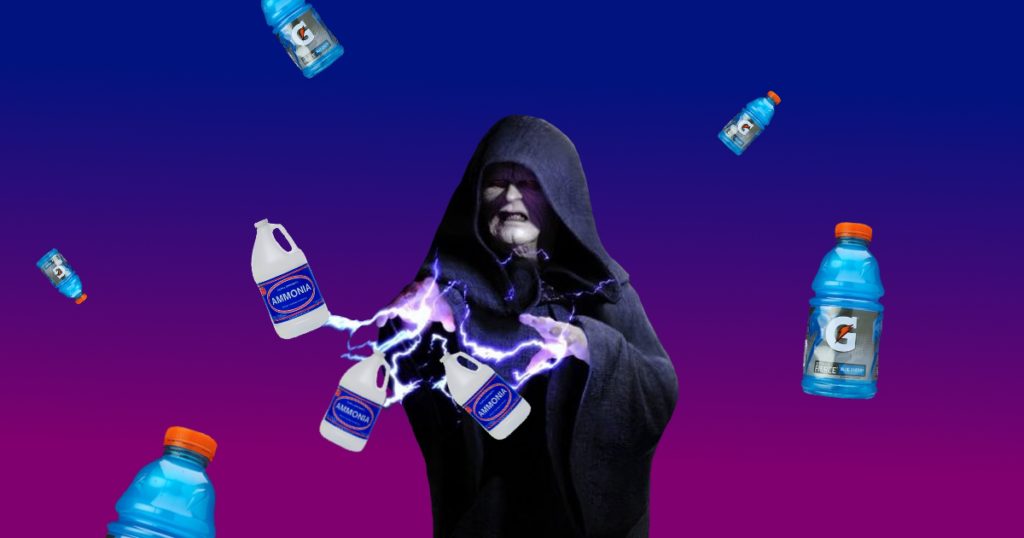
Products that contain artificial food dye, like Kool-Aid and Gatorade, easily stain carpet. The secret to removing the stains is ammonia, and I’m about to teach you exactly how to use it.
(To discover how to remove organic stains like urine, blood and grass stains, check out this article now!)
Before we get started, here’s a list of things you’ll need. It might seem confusing now, but I promise it’ll all make sense by the end of this charmingly well-written article:
1. Bottle of ammonia.
Doesn’t matter what size. A pint, a gallon–whatever. Doesn’t matter what brand. Generic is fine. It probably all comes from the same Chinese sweatshop anyway.
2. Spray bottle to hold the ammonia.
An empty, rinsed-out Windex bottle works great. Or you can buy a trigger sprayer bottle at Lowe’s or Home Depot for about $3. Just make sure you don’t mix ammonia with other chemicals, especially bleach. If you reuse a bottle from some other cleaning product, rinse it thoroughly before filling with ammonia.
NOTE: I’ve seen ammonia that comes in a spray bottle, but I don’t remember where. It may have been Home Depot. If you can find it, you can kill two birds with one stone.
3. Clean white towel.
Choose a towel you don’t mind ruining. Terry cloth is preferable. Jersey fabric, like an old t-shirt, doesn’t work as well. Something the size of a hand towel would be best, because you’ll be getting it wet and ringing it out. A huge bath towel will be unwieldy and annoying. If that’s all you have, consider cutting it into 12″x12″ squares. Better yet, buy a pack of terry towels at Lowe’s or Home Depot. A 20-pack is about $10. That’s what I use. They are the perfect size and shape for our needs, which I’ll explain in a moment. Do NOT use colored towels, because you’re about to do some freaky stuff and we don’t want dye from a bright red towel transferring to the carpet, capiche?
4. Clothes iron.
There’s a good chance the iron will be ruined, so don’t use your $100 Rowenta. You can buy a cheap iron for under $10 at Wal-Mart. That’s what I’d suggest using.
Now, I know what you’re thinking. If you don’t have any ammonia, a spray bottle, terry towels or an iron you can ruin, you’re thinking, “Geez, Ross. Don’t be such a big fat idiot. I don’t want to buy literally 14-million items just to remove one stain. What gives?”
Valid point, so you’ll have to determine how bothersome your stain is. Ask yourself if a modest investment is worth getting rid of the stain forever.
I’m not asking you to break the bank, here. Worst case scenario, if you have to purchase all four of the items listed above, you’re looking at about $30-35 after tax. Personally, I think it’s worth it. Professional help would cost much more. To me, thirty bucks seems like a steal.
Anyway, here’s what you do…
The Exact Steps
Let’s use a red Kool-Aid stain as an example. First, you need to remove as much excess material as possible. If the stain is old and dry, that’s fine. Proceed to the next step. But if it just happened, use towels to blot up as much liquid as possible.
Don’t scrub the carpet because you might damage the fibers, which leaves behind a permanent weird-looking frayed spot.
Once you’ve removed the excess liquid, plug the iron in near the stain. It will need to stay plugged in. If it doesn’t reach the stain, use an extension cord.
Now crank the heat as high as it will go. You can fill the iron with water if you want to use the steam setting, but it’s not necessary. I don’t bother with it because it’s an extra step I don’t feel like wasting time on.
The heat from the iron will activate the ammonia (which you’re about to spray on the stain) and accelerate a chemical reaction called reduction. Reduction destroys artificial food dye. Yay, science!
Don’t worry, your carpet is perfectly safe… probably. We’re going to use a terry towel as a barrier to protect the carpet from burning or melting.
So grab a towel and completely soak it under a faucet. Then wring it out, but not too much. Leave it nice and wet, as if it just came out of the washing machine.
You should already have your ammonia in a spray bottle, so go to the stain and hose that sucker down. Again, using a red Kool-Aid stain as an example, all of the red discoloration needs to be wet with ammonia, from the top of each affected carpet fiber to the bottom.
Try to keep the ammonia only on the stained carpet fibers. It’s not a big deal if you get it on surrounding fibers, but try to keep it contained to the stain. Why? Because there’s always a slight chance the ammonia could strip color from your carpet, so there’s no sense in risking healthy, unstained fibers.
Place the damp towel over the stain, and then set the hot iron on top. It’ll sizzle and pop, but don’t let that scare you. The water in the towel will protect the carpet from getting burned.
Leave the iron in place for 20 or 30 seconds, being careful not to inhale steam or fumes. Then carefully lift it and check under the towel to make sure the carpet isn’t melted.
Burning or melting rarely happens–in fact, I’ve never seen it happen. Most carpets in the U.S. are either nylon, polyester, or a blend of the two. The melting point is rather high, so you shouldn’t have any problems.
Olefin carpet has a lower melting point and is more susceptible to heat damage. Many berber carpets are olefin, and they’re often found in basements and cheap housing like apartments and rental homes. If you’re not sure what kind of carpet you have, text a picture of it to me, Ross, and I’ll tell you (317-370-9075).
Okay, back to the stain. You’ve just checked under the towel, correct? Hopefully, the stain will look less vibrant. You may even see that some of the color has transferred onto the towel. That’s great! Apply more ammonia, move a fresh area of the towel over the stain, and replace the iron for another 20 or 30 seconds.
Some stains will be bigger than the iron. It doesn’t really matter how you attack such a stain–you can focus on one area until the discoloration is completely gone, or you can move the iron from place to place to keep each section of the stain at the same point in the process. Either way, the key is to keep the stained fibers wet with ammonia, and to always use a fresh, wet area of the towel.
Don’t place the iron atop an area of the towel that’s been used, because all the moisture will have been fried out of it. Remember, that moisture is what’s keeping your carpet from burning. Always use a wet area of the towel. You can use the same towel indefinitely, just keep it wet. Re-soak it under the faucet occasionally, wring it back out, and proceed.
Final Thoughts
Once the stain is gone or you’re convinced it’s as good as it’s going to get, you should try to remove as much ammonia from the carpet as possible. The easiest way is to suck it out with a Shop-Vac. If that’s not an option for you, put a folded, clean, dry towel over the wet area and stand on it. Your body weight will help soak moisture into the towel.
In my experience, most synthetic stains come out after two to five applications of ammonia and heat. Some stains simply won’t come out. If you reach a point where the stain stops responding, it’s probably permanent and there’s no sense wasting more time on it.
Also, for whatever reason, blue food dye is notoriously hard to remove. You’ll likely have much better success with red food dye. Which is good, because it’s much more common. I see far more red stains than blue stains.
It might be a good idea to test an inconspicuous area like a closet. I’m sure you’d rather know if your carpet is going to melt, or if the ammonia will damage it.
I suggest wearing eye protection and thick work gloves. Thin rubber gloves will protect your skin from ammonia, but won’t do anything to prevent burns if you mishandle the iron. In fact, the iron could melt rubber into your skin, which sounds like a real day ruiner to me.
This process will ruin the bottom of your iron. It will become encrusted with white, chalky ammonia residue that won’t come off. That’s why I strongly suggest using an el cheapo from Walmart. Trust me on this.
Finally, I want to remind you not to inhale the ammonia fumes. It probably won’t kill you, but why risk it?
In case you’re wondering, the process described above isn’t some hillbilly home remedy. It’s the exact process the pros use. I’ve done it for many years and have removed thousands of stains. I’m sure I’ve inhaled ammonia fumes from time to time, but I’m still here, I’m still sexy and I’m still owning life. Just be careful and use common sense.
If You’d Rather Not Try This Yourself…
Of course, some of you would rather not play mad scientist in your own house. If professional help sounds more appealing and you live in or around Indy, call or text me, the ol’ Rosster, at 317-370-9075. I’d be happy to help. If you prefer email, click here to send a message.
Seacrest out.









